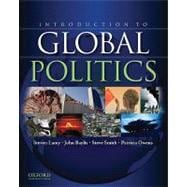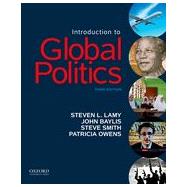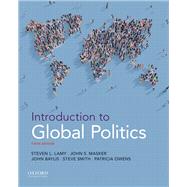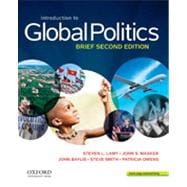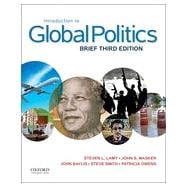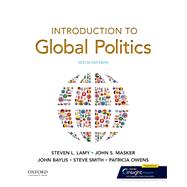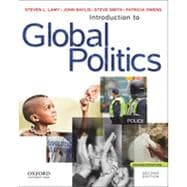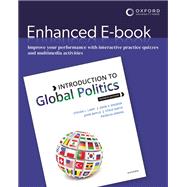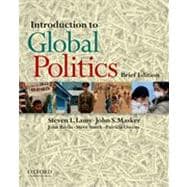Introduction to Global Politics

Introduction to Global Politics
- ISBN 13:
9780190299798
- ISBN 10:
0190299797
- Edition: 4th
- Format: Paperback
- Copyright: 07/20/2016
- Publisher: Oxford University Press
- Newer Edition
Used From $66.54
Sorry, this item is currently unavailable.
List Price $90.61 Save $24.07
Used
$66.54
Usually Ships in 24-48 Hours
We Buy This Book Back!
Included with your book
Free Shipping On Every Order
Note: Supplemental materials are not guaranteed with Rental or Used book purchases.
Extend or Purchase Your Rental at Any Time
Need to keep your rental past your due date? At any time before your due date you can extend or purchase your rental through your account.
Summary
Introduction to Global Politics, Fourth Edition, provides students with a current, engaging, and non-U.S. perspective on global politics. It shows students how to analyze global political events using theoretical approaches-both mainstream and alternative-and emphasizes non-state actors more than any other global politics text.
Chapter-by-Chapter Revisions
Chapter 1: Introduction to Global Politics
-Expanded theoretical coverage introduces students to the three theoretical traditions in international relations theory: Machiavellian, Grotian, and Kantian
-New Case Study: "Global Production and the iPhone"
Chapter 2: The Evolution of Global Politics
-Revised chapter-opening vignette addresses the goals of nation-states for survival and influence in the global system and how critical trends, such as the diffusion of power and increasing demands for vital resources, influence such goals
-Expanded coverage of US-Cuba relations addresses the restoration of diplomatic ties
-Further examination of the war on terrorism, including the completion of NATO's International Security Assistance Force mission in Afghanistan and its subsequent transition to the ongoing Resolute Support Mission
-Updated Global Perspective "Perception, Continuity, and Change After January 20, 2009" addresses the continuing course of the Arab Spring
-Updated statistics and graphics include "Estimated Global Nuclear Warheads, as of 2015," and "Number of Wars in Progress Since 1950"
Chapter 3: Realism, Liberalism, and Critical Theories
-Elimination of overlapping content between Chapter 3 and the first two introductory chapters, effectively streamlining the chapter and bringing its objectives of defining and describing the origins of IR theories, as well as explaining the relation among the levels of analysis and the different variations of the five schools of thought, into clearer focus
-The latest on the most pertinent international relations matters including how world leaders should deal with extremist networks like the Islamic State
Chapter 4: Making Foreign Policy
-Further coverage and analysis of the UN Framework Convention on Climate Change, including the goals of the 2015 Paris Climate Change Conference
-Expanded discussion of fragile states, including updates to the Fragile State Index
-Discussion of foreign policy evaluation has been expanded to include criticism of the CIA's detention and treatment of prisoners taken in the wars in Iraq and Afghanistan
-Additional examples of NGO influence on human rights (i.e. Human Rights Watch pressuring the Chinese government to abolish its re-education through labor detention system)
-Updated statistics and graphics include "Top Ten Foreign Aid Donors" and the addition of a new figure "Share of World Military Expenditures of the 15 States with the Highest Expenditure"
Chapter 5: Global and Regional Governance
-Revised chapter-opening vignette addresses the impact of the Tunisian National Dialogue as a civil society organization and winner of the Nobel Peace Prize
-Updated examples of venture philanthropy include Facebook co-founder and CEO Mark Zuckerberg's pledge to donate 99 percent of his wealth
-Updated Case Study "A Global Campaign: The Baby Milk Advocacy Network" includes recent statistics from the World Health Organization.
-Updated statistics and graphics include "INGO Growth Continues" and "Distribution of Think Tanks in the World"
Chapter 6: Global Security, Military Power, and Terrorism
-Updated information on conflicts including the Syrian civil war, the rise of the Islamic State and their goal to establish an Islamic Caliphate, and the UN peacekeeping mission in the Central African Republic to prevent civil wars and sectarian conflicts
-Condensed coverage of mainstream and critical approaches to security in order to eliminate overlapping content found in Chapter 3: Realism, Liberalism, and Critical Theories
-Added examples of the importance of collective action and reliance on international/regional organization (i.e. in the case of the 2015 Iran nuclear deal)
-Expanded discussion of the effects of nuclear weapons and the idea that the international community is experiencing a new nuclear age in which weapons of mass destruction are used to secure strategic advantage
-Updated Case Study "US Drone Warfare: A Robotic Revolution in Modern Combat" includes recent statistics on drone strikes
-Updated information on the spread of jihadists, Al Qaeda, and ISIS and the geographical extent to which the Obama Administration (and future administrations) will have to go to find them
-Updated statistics and graphics include "Arms Deliveries Worldwide," "Arms Transfer Agreements Worldwide"; the addition of two new figures: "Top Locations of Islamic State Twitter Users" and "Thirteen Years of Terror in Western Europe;" the addition of a new map: "Where ISIS Has Directed and Inspired Attacks;" and the addition of a table detailing the inter-actor relationship of those involved in the Syrian civil war
Chapter 7: Human Rights and Human Security
-Added information on the latest human rights crises (i.e. the refugee crisis, the Syrian civil war, and South Sudan)
-New Case Study "A Failed Intervention" on the genocide occurring in Darfur
-Updated statistics on current UN peacekeeping operations
Chapter 8: Global Trade and Finance
-Updated analysis on the current status of global economic interconnection (i.e. the role that governmental intervention has on the economy of their nation-states--including free markets, the impact of the slowdown of China's economy, and the effects of increasing global foreign direct investment)
-New discussion of the Trans-Pacific Partnership and its subsequent implications as the largest regional trade agreement in history
-Updated Theory in Practice "Contending Views of Capitalism" reflects recent changes in the Chinese economy and cyberwarfare tactics it uses against the US
-Updated statistics and graphics include "Main Trading Nations," "Real GDP Growth," and the addition of a new graph "Holdings of US Treasury Securities"
Chapter 9: Poverty, Development, and Hunger
-Added discussion on the results of the Millennium Development Goals process (including an updated Progress Chart for UN Millennium Development Goals) and the UN's subsequent adoption of the new 2030 Agenda for Sustainable Development (illustrated by Sustainable Development Goals).
-Updated discussions of world population statistics and estimated population growth projections, including new graphics "Projected World Population" and "Fastest Growing Populations"
Chapter 10: Environmental Issues
-Discussion of the latest environmental issues including the rising number of carbon emissions emitted on the planet, the effect climate change and environmental degradation are having as causes of major violence in regards to specific ethnic communities that compete for scarce resources, and how 2015 was the hottest year in recorded history
-Added discussion of how climate change is the greatest challenge to economic and political stability across the world
-Revised discussion of the latest Intergovernmental Panel on Climate Change report addresses the rise of global surface temperatures, the continued shrinking of sea ice, and how human influence correlates to climate change and increasing levels of greenhouse gas emissions in the atmosphere
-Added information and analysis of the 2015 Paris Climate Change Conference, its outcomes, and the importance of adhering to pledges to curb emissions and keeping global temperature rises under 2 degrees Celsius; new concluding thoughts and analysis added
Chapter-by-Chapter Revisions
Chapter 1: Introduction to Global Politics
-Expanded theoretical coverage introduces students to the three theoretical traditions in international relations theory: Machiavellian, Grotian, and Kantian
-New Case Study: "Global Production and the iPhone"
Chapter 2: The Evolution of Global Politics
-Revised chapter-opening vignette addresses the goals of nation-states for survival and influence in the global system and how critical trends, such as the diffusion of power and increasing demands for vital resources, influence such goals
-Expanded coverage of US-Cuba relations addresses the restoration of diplomatic ties
-Further examination of the war on terrorism, including the completion of NATO's International Security Assistance Force mission in Afghanistan and its subsequent transition to the ongoing Resolute Support Mission
-Updated Global Perspective "Perception, Continuity, and Change After January 20, 2009" addresses the continuing course of the Arab Spring
-Updated statistics and graphics include "Estimated Global Nuclear Warheads, as of 2015," and "Number of Wars in Progress Since 1950"
Chapter 3: Realism, Liberalism, and Critical Theories
-Elimination of overlapping content between Chapter 3 and the first two introductory chapters, effectively streamlining the chapter and bringing its objectives of defining and describing the origins of IR theories, as well as explaining the relation among the levels of analysis and the different variations of the five schools of thought, into clearer focus
-The latest on the most pertinent international relations matters including how world leaders should deal with extremist networks like the Islamic State
Chapter 4: Making Foreign Policy
-Further coverage and analysis of the UN Framework Convention on Climate Change, including the goals of the 2015 Paris Climate Change Conference
-Expanded discussion of fragile states, including updates to the Fragile State Index
-Discussion of foreign policy evaluation has been expanded to include criticism of the CIA's detention and treatment of prisoners taken in the wars in Iraq and Afghanistan
-Additional examples of NGO influence on human rights (i.e. Human Rights Watch pressuring the Chinese government to abolish its re-education through labor detention system)
-Updated statistics and graphics include "Top Ten Foreign Aid Donors" and the addition of a new figure "Share of World Military Expenditures of the 15 States with the Highest Expenditure"
Chapter 5: Global and Regional Governance
-Revised chapter-opening vignette addresses the impact of the Tunisian National Dialogue as a civil society organization and winner of the Nobel Peace Prize
-Updated examples of venture philanthropy include Facebook co-founder and CEO Mark Zuckerberg's pledge to donate 99 percent of his wealth
-Updated Case Study "A Global Campaign: The Baby Milk Advocacy Network" includes recent statistics from the World Health Organization.
-Updated statistics and graphics include "INGO Growth Continues" and "Distribution of Think Tanks in the World"
Chapter 6: Global Security, Military Power, and Terrorism
-Updated information on conflicts including the Syrian civil war, the rise of the Islamic State and their goal to establish an Islamic Caliphate, and the UN peacekeeping mission in the Central African Republic to prevent civil wars and sectarian conflicts
-Condensed coverage of mainstream and critical approaches to security in order to eliminate overlapping content found in Chapter 3: Realism, Liberalism, and Critical Theories
-Added examples of the importance of collective action and reliance on international/regional organization (i.e. in the case of the 2015 Iran nuclear deal)
-Expanded discussion of the effects of nuclear weapons and the idea that the international community is experiencing a new nuclear age in which weapons of mass destruction are used to secure strategic advantage
-Updated Case Study "US Drone Warfare: A Robotic Revolution in Modern Combat" includes recent statistics on drone strikes
-Updated information on the spread of jihadists, Al Qaeda, and ISIS and the geographical extent to which the Obama Administration (and future administrations) will have to go to find them
-Updated statistics and graphics include "Arms Deliveries Worldwide," "Arms Transfer Agreements Worldwide"; the addition of two new figures: "Top Locations of Islamic State Twitter Users" and "Thirteen Years of Terror in Western Europe;" the addition of a new map: "Where ISIS Has Directed and Inspired Attacks;" and the addition of a table detailing the inter-actor relationship of those involved in the Syrian civil war
Chapter 7: Human Rights and Human Security
-Added information on the latest human rights crises (i.e. the refugee crisis, the Syrian civil war, and South Sudan)
-New Case Study "A Failed Intervention" on the genocide occurring in Darfur
-Updated statistics on current UN peacekeeping operations
Chapter 8: Global Trade and Finance
-Updated analysis on the current status of global economic interconnection (i.e. the role that governmental intervention has on the economy of their nation-states--including free markets, the impact of the slowdown of China's economy, and the effects of increasing global foreign direct investment)
-New discussion of the Trans-Pacific Partnership and its subsequent implications as the largest regional trade agreement in history
-Updated Theory in Practice "Contending Views of Capitalism" reflects recent changes in the Chinese economy and cyberwarfare tactics it uses against the US
-Updated statistics and graphics include "Main Trading Nations," "Real GDP Growth," and the addition of a new graph "Holdings of US Treasury Securities"
Chapter 9: Poverty, Development, and Hunger
-Added discussion on the results of the Millennium Development Goals process (including an updated Progress Chart for UN Millennium Development Goals) and the UN's subsequent adoption of the new 2030 Agenda for Sustainable Development (illustrated by Sustainable Development Goals).
-Updated discussions of world population statistics and estimated population growth projections, including new graphics "Projected World Population" and "Fastest Growing Populations"
Chapter 10: Environmental Issues
-Discussion of the latest environmental issues including the rising number of carbon emissions emitted on the planet, the effect climate change and environmental degradation are having as causes of major violence in regards to specific ethnic communities that compete for scarce resources, and how 2015 was the hottest year in recorded history
-Added discussion of how climate change is the greatest challenge to economic and political stability across the world
-Revised discussion of the latest Intergovernmental Panel on Climate Change report addresses the rise of global surface temperatures, the continued shrinking of sea ice, and how human influence correlates to climate change and increasing levels of greenhouse gas emissions in the atmosphere
-Added information and analysis of the 2015 Paris Climate Change Conference, its outcomes, and the importance of adhering to pledges to curb emissions and keeping global temperature rises under 2 degrees Celsius; new concluding thoughts and analysis added




